| ☰ Menu | Total Solar Eclipse Airborne |

Abstract
This page describes the preparations for an airborne campaign where the target is hyperspectral imaging of
the total eclipse that will occur over Svalbard 20th of March 2015. The use of an airborne carrier guaranties
us clear view of the event in case of cloudy weather. The instrument under construction is presented together
with experimental setup and mission timeline.
1. Objective
The main objective of the airborne mission is to study and map the Sun's corona with a medium resolution spectral camera.
The second aim is to test the gyro stabilization method of the camera.
Color video footage and still images will be taken to support the experiment.
2. Simulated view of the event
The totality of the event is only 147 seconds beginning at ~10:10 UT. From Longyearbyen (LYR), the event is seen
166o South-East and 11o above the horizon. Figure 1 shows a simulated view of the eclipse
as seen from the old Auroral Station in Adventdalen. Detailed calculations of the trajectory of the
eclipse is found below [1,2] .
3. Experimental setup

The instruments are mounted into a DORNIER 228-202K airplane, operated by Lufttransport AS, and normally used for transporting people and goods to Ny-Aalesund and Svea. A sliding door which can be opened in flight is used, allowing an unobstructed field of view sideways out of the plane.
Figures 2 and 3 show the experimental setup used by our yearly airborne campaigns through the UNIS AGF-331 spectroscopy courses (1999-2007) [3-8].
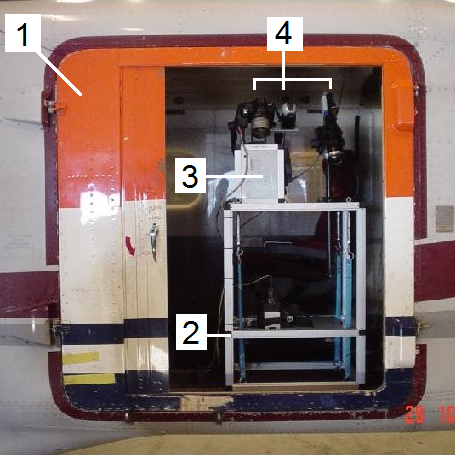
We aim to use the same setup for the new hyperspectral camera described below.
4. The hyperspectral camera
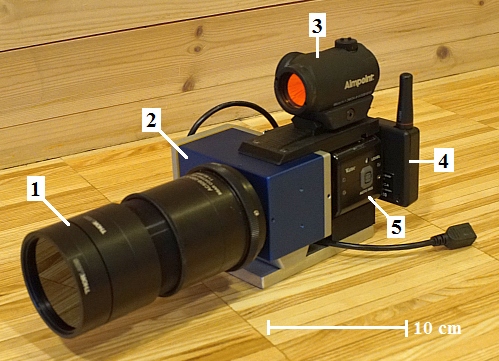
The core instrument is a prototype hyperspectral camera designed for the event. See above Figure 4.
It uses an electro-optical Liquid Crystal Tunable Filter (LCTF) to image any object as a function of
wavelength throughout the visible spectrum with no moving mechanical parts.
We use these types of filters in our auroral all-sky cameras named NORUSCA II [9].
Figure 5 shows the camera mounted by an elastic rope to a 90o arm. The camera is stabilized by high speed gyro wheels [10].
The plan is to manually point the camera by hand at the target during flight. Note that Solar filters will be used prior and after the totality for protection.
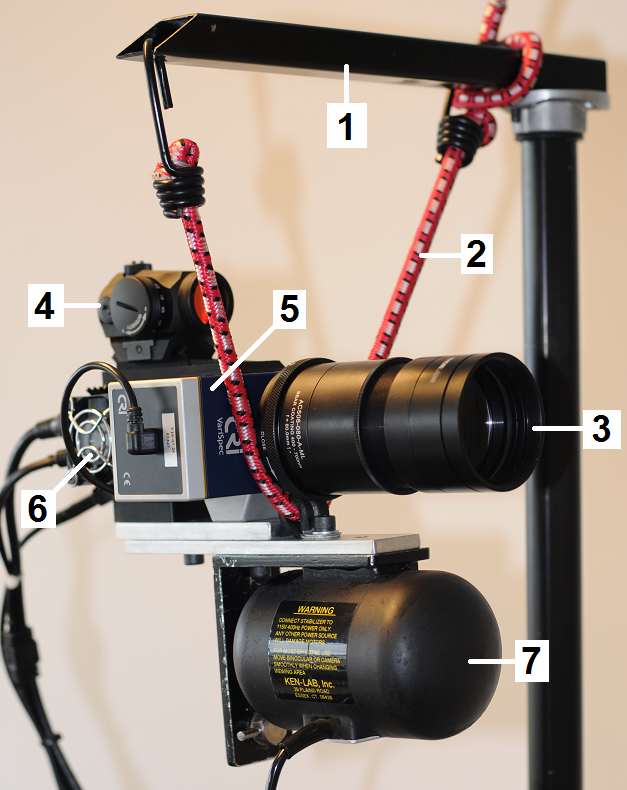
Table 1 lists the key specifications of the instrument.
| Items | Description | |
| (A) Camera head | Astrovid | Stellacam3 |
| Sensor size | 1/2" CCD | Watec 120+ |
| Size | 4.9784 x 6.8124 mm2 | 811(H) x 508(V) |
| Image | Diameter | 8.43761 mm |
| Frame rate | 25 Hz | Composite video (NTSC) |
| Cooling | Peltier | -20oC |
| Power input | External | +12VDC |
| Minimum Illumination | F/1.4 | 0.00002 Lux |
| Exposure & Gain Control | Manual | Radio |
| Options | Deep sky | Frame accumulation |
| - | - | |
| (B) Wavelength filter | LCTF | VariSpec |
| Spectral range | Visible | 400-720 nm |
| Bandpass | Full Width Half Maximum | ~7 nm |
| Time to swap channels | Optics response time | 50 ms |
| Collimation | Half angle of acceptance | 7.5o |
| Aperture | Diameter | 22 mm |
| Power input | External | USB |
| - | - | |
| (C) Lens | Thorlabs | |
| Model | AC508-150-A-ML | |
| Focal length | 150 mm | |
| F/value | 4.8 | |
| Effective aperture | 31 mm | |
| Field of view (FOV) | 3.2o | |
| - | - | |
| (E) Assembled | Hyperspectral camera | |
| Width | 112 mm | |
| Length | 240 mm | |
| Mass | 1.169kg |
The analog video signal is digitized by a video to USB 2 converter (model DFG/USB-It) from the company ImagingSource [11]. A laptop PC stores the movie using optional Xvid compression to reduce storage disk space.
Due to the long Back Focal Length (BFL=62.5 mm) of the system, the distance from the input flange of the LCTF to the CCD, a custom made lens has been constructed using the 2 inch lens tube assembly from the company Thorlabs [12]. The design and parts are shown in Figure 6.
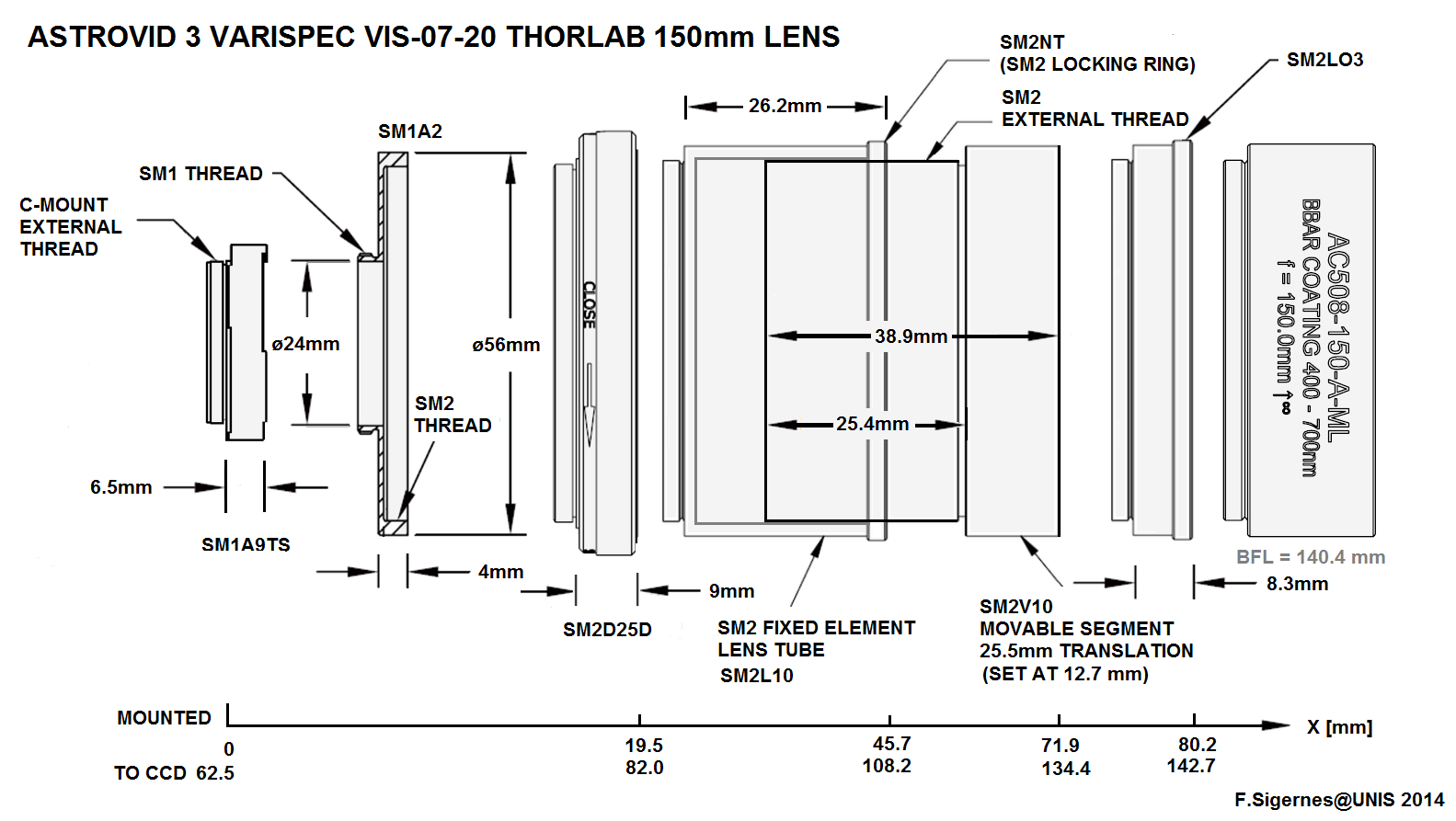
Discussion, training and testing of the above setup are necessary to make sure that the operator is eye safe. Especially, the method of pointing should be evaluated. A pinhole with a screen could be a safer solution than forcing the operator to look through the solar filtered aimpoint.
5. First test of the camera
The first test of the camera was conducted on Monday 15th of September 2014 at the roof of The University Centre in Svalbard (UNIS). The target was the Moon. Figure 7 shows an image of the Moon taken at center wavelength 650 nm. The image is taken during daytime with partly cloudy sky conditions at 12:43:47 UT. Moon phase is 56%. The elevation is 11o above the horizon to the North-West (308o). The sun was 13o above the horizon at azimuth 209o (South-West).
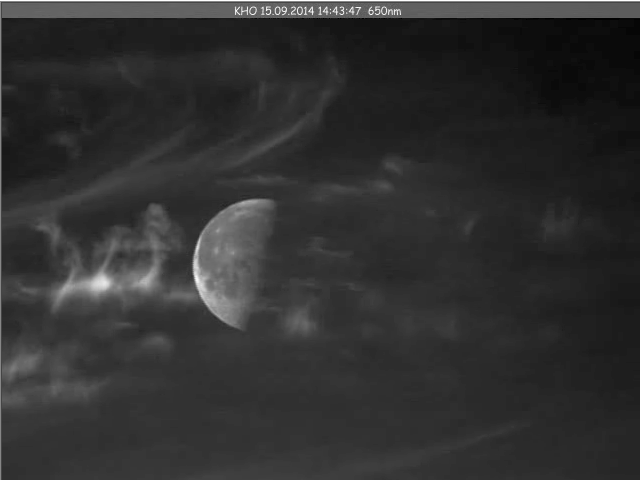
The LCTF filter was setup to sweep in wavelength from 400 to 720 nm with incremental steps of 10 nm. The duration of each wavelength interval (epoch) was set to 1 second. The exposure time of the camera was set to 17 msec at gain equal to 50. The net result is a spectral movie at 25 frames per second. The size of each frame is 640 x 480 pixels. The spectral movie can be downloaded below.
Spectral movie of the Moon (formats): [wmv] [mpg] [avi]
From the movie we can see that it is possible to point fairly accurate with the camera. Note that the exposure time must be kept as short as possible to avoid blurry images during flight. The effective spectral range of the camera is found to be 480 - 720 nm due to the low transmission of the LCTF filter in the blue part of the spectrum (400-470 nm).
A key challenge is to choose the correct exposure and gain values without overexposure as the LCTF sweeps in wavelength. This requires a second operator to manually view the video stream and set the appropriate values.
6. Second test of the camera
The next test is to install the BAADER AstroSolar Safety Film[13] in front of the aimpoint and a Neutral Density (ND5) glass filter (NE2R50A) in front of Thorlab lens. The second target is the Sun itself. Figure 8 shows the solar disk at 530.3 nm.
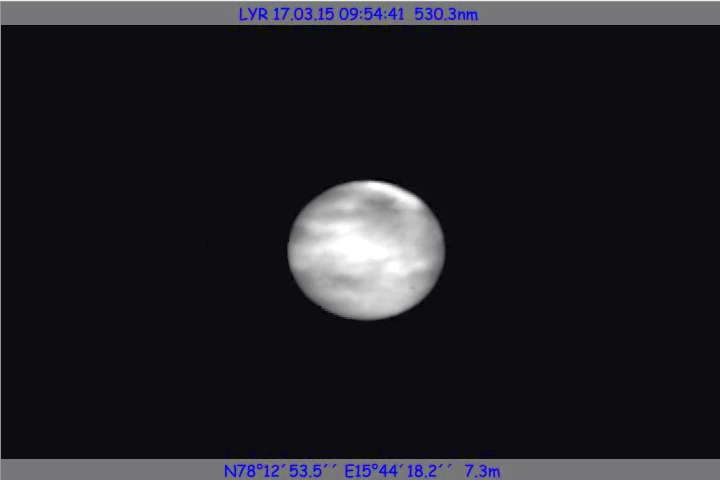
Again the view to the target was obscured by a thin layer of low altitude clouds that drifted across our field of view. The main aim of this test was to find gain and exposure settings, and to test the pointing stability of the camera. See film link below.
Solar movie at 530 nm (formats): [wmv] [mpg] [avi]
7. Mission timeline and wavepoints
The door of the Dornier is located on the left side of the plane as drawn in Figure 2. The camera angle will then be ~90o off the flight direction. Altitude is maximum 10.000 feet (3048 m) without oxygen support and speed will be ~110 knot or 203.72 km/hr. The totality as seen from Longyearbyen (78.2228oN, 15.6528oE) is 147.5 seconds at 166.5o in azimuth. This only corresponds to a flight distance of 7.588 km. The bearing of the plane should then be 256.5 degrees. Co-ordinates are given in latitude, longitude (geographic) and also UTM easting northing 33X WGS 84 See Figure 9 and Table 2 for details.

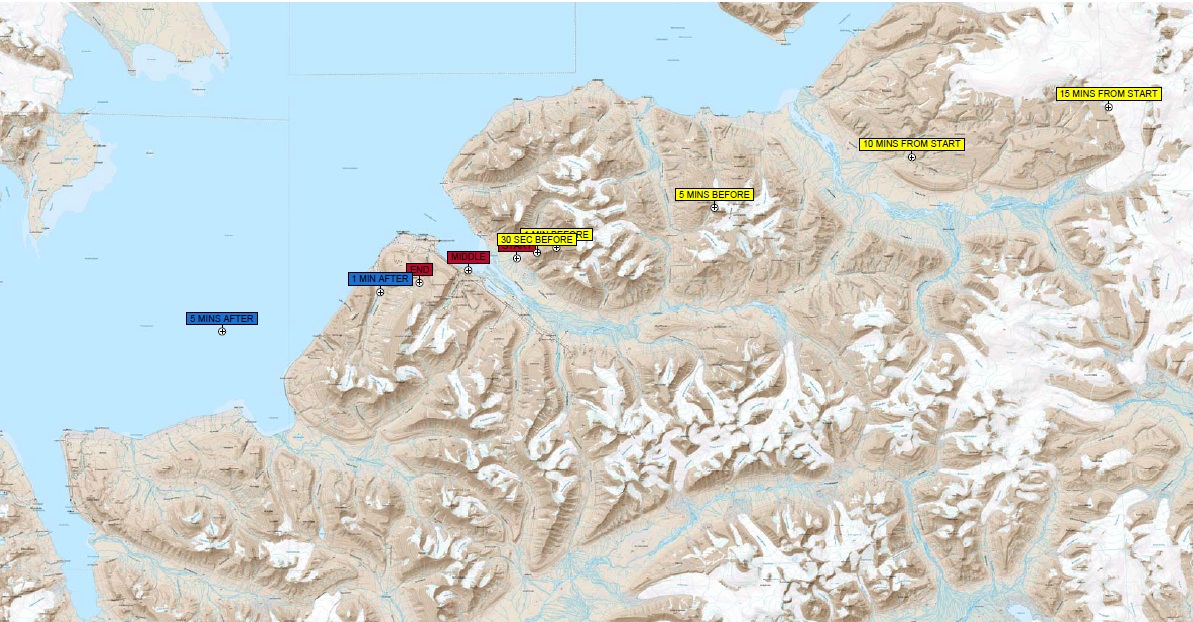
| Wavepoints | Time [UT] | Latitude [oN] | Longitude [oE] |
| 15 mins before 2nd contact | 09:55:44 | 78.329576 | 18.021295 |
| 10 mins before 2nd contact | 10:00:44 | 78.298738 | 17.287311 |
| 5 mins before 2nd contact | 10:05:44 | 78.266043 | 16.557244 |
| 1 min before 2nd contact | 10:09:44 | 78.238559 | 15.976141 |
| 30 secs before 2nd contact | 10:10:14 | 78.235041 | 15.903693 |
| Start of total eclipse (C2): | 10:10:44 | 78.230476 | 15.815354 |
| Start +30 seconds | 10:11:14 | 78.227950 | 15.758925 |
| Start+60 seconds | 10:11:44 | 78.224377 | 15.686606 |
| Maximum eclipse (M): | 10:11:57 | 78.222800 | 15.652800 |
| Start+90 seonds | 10:12:14 | 78.220787 | 15.614330 |
| Start+120 seconds | 10:12:44 | 78.217178 | 15.542098 |
| End of total eclipse (C3): | 10:13:11 | 78.215063 | 15.490970 |
| 1 min after 3rd contact | 10:14:11 | 78.206873 | 15.330040 |
| 5 mins after 3rd contact | 10:18:11 | 78.177638 | 14.753903 |
8. Ground-based support
Both the old Auroral station in Adventdalen and KHO will be operative.
9. First raw data from the hyperspectral camera
The campaign was a success. Smooth flying conditions at an altitude of 2721 m made the pointing easy. A sample frame from the hyperspectral movie is shown below. The center wavelength of the camera is at 656.3 nm (Hydrogen line: Hα).


A raw data spectral film strip is showen in Fig. 10. Note that both the exposure time and gain are changed continuously in order to capture the whole dynamic range for each wavelength. We look forward to process the data frame by frame.
References with links
[1] Fred Espenak, NASA Eclipse Web site.
[2] Kjellmar Oksavik, The Eclipse trajectory over Svalbard.
[3] Airspex 2000, An airborne campaign in imaging spectroscopy.
[4] Dave-2001, an Airborne Experiment by the AGF-330 Students.
[5] Airspex 2004 poster.
[6] Airspex 2005, An airborne Campaign in Imaging Spectroscopy.
[7] Airspex2006, 7'th Airborne Campaign in Imaging Spectroscopy.
[8] Airspex 2007, An airborne Campaign in Imaging Spectroscopy.
[9] Hyperspectral all-sky imaging of auroras
[10] Kenyon Gyro Stabilizers
[11] The ImagingSource - Technology based on standards
[12] Thorlabs, Inc.
[13] BAADER AstroSolar Safety Film
F. Sigernes